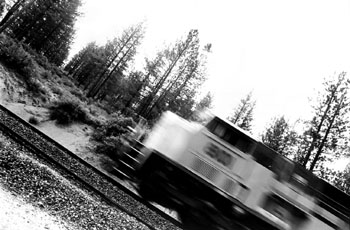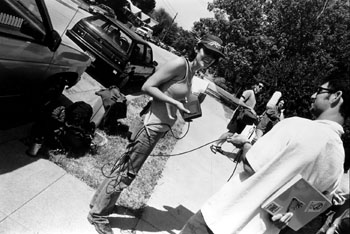![[Metroactive Features]](/gifs/feat468.gif)
[ Movies Index | Show Times | Santa Cruz | Metroactive Home | Archives ]
Dude, Where's My Train?
The elusive American hobo is caught on tape in Sarah George's documentary 'Catching Out'
By Mike 'the Trainiac' Connor
Documentary filmmaker Sarah George's mother wasn't exactly thrilled when she found out her daughter was making a film about hobos and train hopping. "Why can't you make a film about weaving?" she asked her daughter, half-joking, half-serious.
How quaint, right? As if train hopping is even dangerous. Sure, there's some risk involved when tender little humans play around on 200-ton beasts of cold, hard steel racing across the country at brain-clattering, limb-destroying, bone-pulverizing speeds. Plus, it's illegal. But come on, it's nothing for a mother to lose sleep over or anything.
And when it comes right down to it, the history of weaving is not anywhere near as romantic as train-hopping lore. For instance, while the Great American Weaving Song remains to be written, storytelling heavyweights like Johnny Cash, Utah Phillips, Woody Guthrie and Bob Dylan have all weighed in with hard-travelin' odes to the railroads. Old-timey images of squinty-eyed hobos with deep lines in their faces sharing a nip of whiskey from a flask come to mind, walking down the tracks with bindles (those polka-dot-handkerchief pouches tied to a stick) resting on their shoulders.
Though they may be carrying backpacks instead of bindles these days, hobos are still roaming around the country outside of mainstream society, exposed to the elements, piggybacking on lumbering steel, living off the leftovers of society.
George, whose documentary film Catching Out (the colloquial term for hopping a freight train) will appear at the Rio Theatre on March 28, has logged over 10,000 miles riding the rails around the country. Her film uncovers a fascinating subculture of old-timers, young punks, stamp tramps and yuppie riders that populate the train yards. They have their own jargon. They have support networks. They have hobo conventions. They even have hobo zines and "hobo erotica." In a deeply personal way, the film touches on the freedom, hardships and surprisingly complex politics of contemporary train riding.
Camera Shy
Finding compelling subjects was, of course, a major concern. "Just going out there and hoping to find people doesn't work," says George.
As a way of making contacts, she set up a website with pictures and information about what she wanted to do. Shortly thereafter, Union Pacific contacted her, informing George that if she or her film crew were found on UP property, they would be promptly arrested. The vigilance of railroad companies keeps train hoppers ultrasensitive about any sort of media attention, making it that much more difficult to find subjects willing to sit in front of the camera.
Getting the footage wasn't easy, either.
"Shooting on moving freight trains presented a logistical challenge," George says. "Camera equipment was packed in custom-rigged backpacks to disguise us as common tramps."
Not that George was aiming for the vérité style. "Shooting the film and knowing the characters in advance, I scouted certain rail lines, drove to a train yard with the characters and a small crew, and hopped the train with a follow van. In that sense, it was a very Hollywood way of making a film, but it was the best way for what my objectives were."
George says that, ultimately, she considers Catching Out "a meditation on the search for freedom."
"When I first thought of the idea, I just thought it was an oddity, a cute American story," she says. "When I went out and actually experienced it, I immediately connected with the experience and realized there's a much bigger story. It's this intense experience of freedom, completely exhilarating and totally addicting."
I Am a Lonesome Hobo
Along with plenty of beautiful train's-eye vistas in the film, George zeros in on the lives of four individuals--Jessica, the young, college-educated wanderer; the tramp couple Switch and Baby Girl; and an eco-activist outdoorsman named Lee--and follows them off the tracks to delve deeper into their lives. Jessica winds up settling in San Francisco to reconnect with friends and family; Switch and Baby Girl give up the freedom of train hopping to raise their newborn son. Lee is in it for the long haul, though, exuding an infectious sense of satisfaction with his chosen lifestyle. His parents respect their son's dedication to his chosen eco-causes, but stop short of hopping trains along with their son.
"I'd make a terrible hobo," Lee's mother laughs, making the point that the hobo way of life isn't for everyone. Showers and warm beds are a rarity in a world where dumpsters are your only buffet. Train hoppers get their kicks without seat belts or health insurance, nor any reliable source of income. Catching Out offers some insight into the types of people who suffer such hardships in exchange for expansive freedom and nontraditional community, but Lee points out that the stories told in the film are not necessarily the norm.
"I would say it's a cross-section. I wouldn't say that it's 'representative,' necessarily." Lee says that the Central American migrant workers (who aren't represented in the film) heading up to Washington and elsewhere to find work at the fruit harvests are the closest embodiment of the old-fashioned definition of a hobo. The origins of the word are unclear, but Lee explains one of its popular etymologies.
"The first train hoppers were Civil War veterans. When the war was over, people who were a little shell-shocked and/or physically handicapped--and this is the same reason that Vietnam vets started hitting the rails in the '70s and '80s, something's fucked up in their lives and they can't settle back into American culture--well, the very first hobos were these Civil War veterans, and they carried hoes with them on the road and worked as gardeners, and they'd put all their possessions in a coat or a bag on the end of their hoes, like the cartoon image. And so, one theory is that people called them 'hoe-boys' and it just got turned into 'hobos.'"
Hobos From Hell
Although Lee is a wealth of hobo lore and information, he's not the only one--many modern-day hobos find a connection with the romantic history of trains. Right here in Santa Cruz, the "Hobos From Hell" headquarters is filled with hobo cultural artifacts. The purveyor keeps the cozy quarters meticulously organized so that hundreds of books, manuals, pamphlets, zines, pictures, music and even a wealth of tasteful "hobo erotica" are instantly accessible. Free Radio Santa Cruz broadcasts the Hobo Music Show on Tuesdays from 6:30pm to 8pm, playing an excellent mix of blues, folk, stories, rock, bluegrass, country and interviews.
Granted, no amount of vicarious train hopping can replace the real thing--that intoxicating feeling of jumping onto a moving train, the sensation of attaching your puny little self to sheer, hulking momentum, the wind in your face, the smell of diesel in your nose, and the relentless cacophony of metal banging and screeching against metal.
As Jessica's boyfriend Dan puts it, "I just absolutely fell in love with the lifestyle, and with the trains and with the misery that accompanies it all."
"I often feel like I'm having a wilderness experience when I'm on the trains," says Lee. He smiles a lot when he talks about jumping trains and tends to wax poetic, comparing the hypnotic squealing of train breaks to whale song. "It's just you and the train, and the highway is so far away."
Sounds romantic, no? But grabbing your rucksack and heading out to the nearest train yard just because it sounds like fun is a lot like a novice going out and climbing Half Dome just because a professional rock climber said it was beautiful up there.
"It is dangerous, and it is illegal, but there are certain ways to minimize risks," George explains. "I feel safer on a freight train than on a plane; it's statistically less dangerous than driving a car, but you have to minimize the risk. Having a mentor and having a body of knowledge will get you a long way, but the most important thing is not to be intoxicated by drugs or alcohol. Most of the stories you hear about people losing limbs or lives have something to do with drug and alcohol use."
George points out that she intentionally avoided giving out specific how-to information in the film. "I certainly welcome people who are interested and curious to try it out," she says, "but by reading an article or seeing a movie, they're not going to learn what they need to know, so I don't want to entice them to think it's enough. They need to find a mentor. That's how most people learn the ropes."
While you search for a mentor to help you gain your freedom, please enjoy this little verbal trip in closing, courtesy of Lee:
"There's all this crap surrounding highways and auto culture: billboards, stop-and-go's, all the advertising, even the buildings themselves face the road. Trains are kind of the opposite because they're facing the backside of everything. And even when you're in cities, the freight yards and the tracks tend to be in the industrialized sections, so you're looking right into the factories and that whole kind of postapocalyptic funkola part of cities, right? Because nobody dresses up anything for the trains; you're looking at the raw side of the industrial areas of town. And that even goes for the urban and suburban areas you go through, you're really looking into people's backyards. The tracks cut through everything. I like to think of it as a more honest picture of where America's at. You're literally looking into the backyard of our culture."
[ Santa Cruz | Metroactive Central | Archives ]
Copyright © Metro Publishing Inc. Maintained by Boulevards New Media.
![]()

Mysteries of the Unexplained: This blurry photo taken by a frightened camper has true believers convinced trains do exist.

Bad Dog: As the train sped away, Lassie's puppy Lucky thought, 'If Timmy likes falling down the well so damn much, he can just stay there.'

Train on the Brain: 'Catching Out' director Susan George at work.
'Catching Out' will be screened Friday, March 28, at 7pm at the Rio Theatre, 1205 Soquel Ave., Santa Cruz. Tickets are $5 at the door.
From the March 26-April 2, 2003 issue of Metro Santa Cruz.